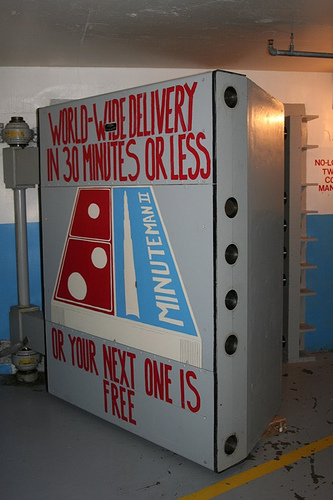In the lead up to the Nuclear Nonproliferation Treaty Review Conference (NPT RevCon, for those who enjoy acronyms), opening today, the U.S. Bureau of International Security and Nonproliferation released a fact sheet titled “Myths and Facts Regarding the Nuclear Nonproliferation Treaty and Regime.”
Judging by the selection of “myths” they chose to include, the United States seems to be feeling a bit defensive about its track record in making progress towards the main objective of the NPT—nuclear disarmament. That is the central bargain of the NPT: the five countries designated as nuclear weapon states—the United States, Russia, China, the United Kingdom, and France—agree to give up their nuclear weapons in exchange for all the other non-nuclear weapon states agreeing not to develop or acquire nuclear weapons of their own.

The blast door to a launch control facility at a decommissioned Minuteman II missile site (now a historical site) in South Dakota advertising the U.S. ability to deliver its nuclear missiles around the globe in half an hour. (Source: jason.stajich)
Review conferences for the NPT take place every five years, giving all 191 states a chance to weigh in on what progress has been made and what actions are needed in the coming years to achieve the treaty’s goals. The mood among the non-nuclear states at the 2015 RevCon is expected to be impatience at what is widely seen as lackluster U.S. action in the wake of the 2010 conference. In view of this, the U.S. fact sheet includes several “myths” that seem aimed at preempting criticism of its lack of progress toward disarmament.
Hair-trigger alert
One in particular jumped out at me: Myth 6 states that “‘Hair-trigger’ alert status and failures to take proper care of nuclear weapons are accidents waiting to happen, and demonstrate the urgent need to eliminate all nuclear weapons.”
Whoever wrote this mixed several different issues, so it’s worth taking a closer look.
First, it’s unhelpful that the first U.S. response to this “myth” relies on semantics—denying that “hair-trigger” is an appropriate description of the alert status of U.S. nuclear forces. Technically, it is true that the U.S. military does not use this term—it prefers more benign-sounding phrases, like “prompt-launch” or “ready alert” status. However, for those not fluent in military-speak, describing nuclear weapons that can be launched within minutes as being on “hair-trigger” alert is not much of a stretch. Moreover, it is a term that has been widely used by political and military leaders, including Presidents Bush and Obama.
Second, the U.S. response cites “multiple, rigorous and redundant technical and procedural safeguards” that prevent accidental or unauthorized launch, and states that the United States is “taking further steps to maximize decision time for the President in a crisis.” While it is true that U.S. nuclear weapons do employ many safeguards, it is unfortunately also true that no system is foolproof. And even if an accidental or unauthorized launch is avoided, the U.S. insistence on maintaining the option of launch-on-warning opens the door to a mistaken launch—namely, a deliberate launch in response to erroneous or ambiguous warning of an incoming attack. False information or misinterpretation of information from early warning systems has in the past led both the United States and Russia to believe that an attack was underway. In this case, if either the U.S. or Russian president decided to launch, the safeguards intended to prevent unintended launches would all be removed as part of the launch process.
And while the United States says that it is working to increase presidential decision time, it has so far resisted one of the most obvious ways to do this—by taking its missiles off high alert. The most recent Nuclear Posture Review, in 2010, considered but rejected it. This conclusion was somewhat surprising. Both Barack Obama and George W. Bush as candidates stated their desire to remove U.S. nuclear weapons from high alert, and statements from a wide range of other high ranking military and defense officials also support this change.
International calls for taking missiles off hair-trigger alert
Third, while the United States may think that the dangers from keeping missiles on high alert are a myth, the international consensus is very much against them on this issue.
Last year, 166 states voted to support a UN resolution calling for removing all nuclear weapons from high alert. This year, a coalition of states (including U.S. allies like Japan, Canada, and Germany) known as the Non-Proliferation and Disarmament Initiative (NPDI) plans to bring a working paper before the conference calling on all the nuclear weapon states to take steps to reduce the alert level of nuclear weapons. Thus, the U.S. decision to dismiss such concerns by labeling them a “myth” is unlikely to prove persuasive, or helpful.
Finally, while there are good reasons to eliminate nuclear weapons, the best response to the problems of having missiles on hair-trigger alert is to take them off hair-trigger alert, which can be done quickly.
President Obama can do this
The reason for placing U.S. missiles on high alert in the first place was the fear of a Soviet first strike. But even with current tensions with Russia, this is no longer a realistic fear, and the much more likely danger is an accidental, unauthorized, or mistaken launch.
This is a danger that President Obama can single-handedly end. By announcing that he will use his authority as commander in chief to order U.S. land-based nuclear missiles to be taken off hair-trigger alert, the president would virtually end the risks posed by unintended or mistaken launches. Making this announcement at the RevCon would also send a strong signal that the United States has heard the concerns of the majority of NPT states and is taking concrete measures to reduce the risks posed by its large nuclear arsenal.
Rather than using wordplay to side-step its responsibility, the United States should take the opportunity of the RevCon to reclaim a leadership role in the international nonproliferation and disarmament regime.
